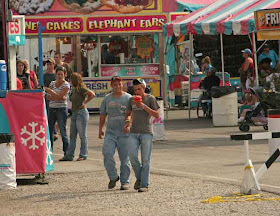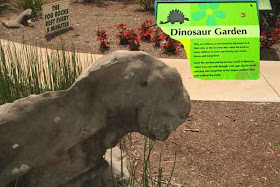
I've been going to the
Missouri State Fair every year since I was 3 years old. My parents didn't have many traditions and they both worked so hard they never took a vacation. Running a small town grocery store was a 12 hour a day, 6 1/2 days a week job. It provided a respectable living for us, but it meant my parents had time for very little joy in their lives.
But a trip to
"The Fair" was one thing they always did. The store would be closed for all day Sunday and Mom & Dad would load up the car about daylight. Mom would have made sandwiches the night before. This was back in the days when there were lots of warnings to fair-goers to avoid foods like potato salad and fried chicken - back in the

days when coolers were rare. So Mom would grind up a variety of cheeses, mix in mayonnaise, pimentos and celery seed, and make a bunch of sandwiches. Those were all wrapped up, then put in plastic bags, then into a box with ice. Iced tea in a jug, potato chips, celery sticks and carrots, and always a pie or dessert, rounded out the meal. My parents had lived through the Depression and buying "expensive" Fair food didn't occur to them.
And that same drinking fountain, above, was a fascination to me as a child. Early on, I couldn't reach the fountain and had to be held. But I always stopped there and drank my fill, wondering where the cold water came from. It's still there, unchanged, still a cool, refreshing spot for a drink.

So in keeping with that tradition, Josh and I still go at least once to the Fair every year. We always visit all the agricultural displays, the Dairy House, to see the one ton cow made of butter. The
FFA (Future Farmers of America) house, with all of the youth vegetable exhibits is fun, as well. I have noticed the changes in what vegetables are displayed over the years. It used to be there was just one kind of eggplant, but in recent years, the Ichiban, a long, slender eggplant has appeared. This year there were several kinds of eggplants on display for judging. And peppers - it used to be simply bell peppers of different sizes and colors. No

w, there are almost as many hot pepper varieties on display as bells.
Pumpkins, herbs of many kinds, watermelons, canteloupes, pumpkins and lots of tomatoes, both heirloom and hybrid, had been judged. It's exciting for me to know there are lots of young people coming along who value gardens, who put in enough time and energy to grow vegetables and to show them at the Fair.

We took in the Midway, always fun for me because I like seeing carnival art. And to see what "weird and unusual" things are on display on the Midway, as well. There used to be the calf with two heads, the woman with a snake's body, a hairless dog and more. When I was about 12 or 13, I started taking a friend or two along with us when we went and the friend and I would leave my parents to explore the "old people's" exhibits and we'd go off to the Midway for the rides. Back then, if you had 25 cents, no matter your age, you could (and we did) get into the girly shows. Not that they were anything exciting, but the idea that we could, "get by" with getting in was the excitement.
Ten cents was the price of admission to see the woman with the snake's body back then. The two headed calf, as you might expect, unless you were 13, was dead and in a jar of formaldehyde. Nearly all of those kinds of exhibits are gone now, and rightly so, but I was surprised to see, "The World's Tiniest Woman" on display. "You can talk to her, she talks to you." Ok, exploitation aside and the sick feeling you get in t

he pit of your stomach, I would assume some little person makes their living being, "The World's Tiniest Woman." I didn't go to see that, however.
I hadna dish of Pineapple Whip ice cream, however and Josh had handmade, homemade vanilla ice cream and we had earlier followed one of our own traditions, which is lunch at the Beef House, which is sponsored by the
Missouri Beef Industry Council. The food is always good, the place clean and the service is outstanding. Servers and cooks are all volunteers from various counties across the State of Missouri.

The grounds of the Missouri State Fair serve other functions during the year. It's home to
State Fair Community College, and the grounds are host to tractor pulls, International Fair and a variety of other events.
But the biggest event ever on the fair grounds, not by size but by impact, was the
Ozark Mountain Music Festival, July 19-21. It was the last of the huge music festivals following Woodstock, and ended the era of the great outdoor music festivals of the 1960s. Sixty thousand young hippies took over the fairgrounds, and the town of Sedalia, for music. Bands playing that weekend included some of the all time greats of that period: the Eagles, Ted Nugent, the Marshall Tucker Band, Jefferson Starship, America, Nitty Gritty Dirty Band, Boz Scaggs, Bachman Turner Overdrive, Bruce Springsteen, Bob Seeger and the Silver Bullet Band, Ozark Mountain Daredevils, Blue Oyster Cult, Aerosmith, Lynyrd Skynnyrd, Charlie Daniels and the Earl Scrub

bs Revue. Wolfman Jack, the famous radiohead was the emcee. Now that really was a concert of a lifetime! I missed Woodstock by being in the military and I missed the Ozark Music Festival by being newly married, employed and too timid to go. That, and I couldn't find anyone to go with me. That year taught me a lot, but one big lesson I learned from missing OMF, was to seize the day - go, and do, instead of always wishing I had.
Jim Ryun, the athlete and runner who broke the world record for the one mile run (3 min. 51 seconds) in the 1960s was also there on stage. (He was a conservative Republican who represented the 2nd District in Kansas, as a U.S. State Representative from 1995 to 2006).
So, with pumpkins, peppers, lots of fish, turtles, snakes, coyotes, deer, great gardens, interesting displays and shows, the Missouri Department o

f Conservation's Gardens, tractor pulls, free music, car races, Demolition Derby and lots more, the fair lived up to all that I've seen and experienced there over the years. Agriculture is alive and well, young people are learning to garden and feed themselves and good, healthy food can still be found at the fair. Fresh roasted corn, anyone?
 This was the third year for the 100 mile yard sale on Missouri Highway 39, going through Monet, Mt. Vernon and onward. Josh and I traveled the route, hoping it was a better organized and supported event than the first year. But it wasn't. Every town we went through, had a few scattered yard sales, but nearly all of the businesses on the town squares were tightly locked up. You'd think the host town businesses would do a little something, maybe a card table out front of their store with outdated merchandise. Something. But none did. They should be embarrassed.
This was the third year for the 100 mile yard sale on Missouri Highway 39, going through Monet, Mt. Vernon and onward. Josh and I traveled the route, hoping it was a better organized and supported event than the first year. But it wasn't. Every town we went through, had a few scattered yard sales, but nearly all of the businesses on the town squares were tightly locked up. You'd think the host town businesses would do a little something, maybe a card table out front of their store with outdated merchandise. Something. But none did. They should be embarrassed. m. The cool, damp summer had caused the leaves to fall, most likely because of leaf fungus, something dogwoods are prone to getting in damp summers. The tree was evidently confused, first by the loss of its leaves, then by the unseasonably cool August weather (last night it was in the mid-40s and felt like fall). The confused tree was full of pink blossoms. It's likely, with the lack of leaves so early and the out of season blooming, the tree will probably not live through the winter.
m. The cool, damp summer had caused the leaves to fall, most likely because of leaf fungus, something dogwoods are prone to getting in damp summers. The tree was evidently confused, first by the loss of its leaves, then by the unseasonably cool August weather (last night it was in the mid-40s and felt like fall). The confused tree was full of pink blossoms. It's likely, with the lack of leaves so early and the out of season blooming, the tree will probably not live through the winter. rbs that grows in the shade. It's the size of a lilac bush and produces spicy leaves, twigs and berries for seasoning soups, stews and venison. It's also a good tea herb for colds and flu in the wintertime. Ours here in the garden next to the Herb Shop already has red berries and is beginning to lose it's already yellowed leaves.
rbs that grows in the shade. It's the size of a lilac bush and produces spicy leaves, twigs and berries for seasoning soups, stews and venison. It's also a good tea herb for colds and flu in the wintertime. Ours here in the garden next to the Herb Shop already has red berries and is beginning to lose it's already yellowed leaves. great sunset the other day. We're on the east side of the big hill, so we seldom see a sunset unless we're out and about.
great sunset the other day. We're on the east side of the big hill, so we seldom see a sunset unless we're out and about.
































